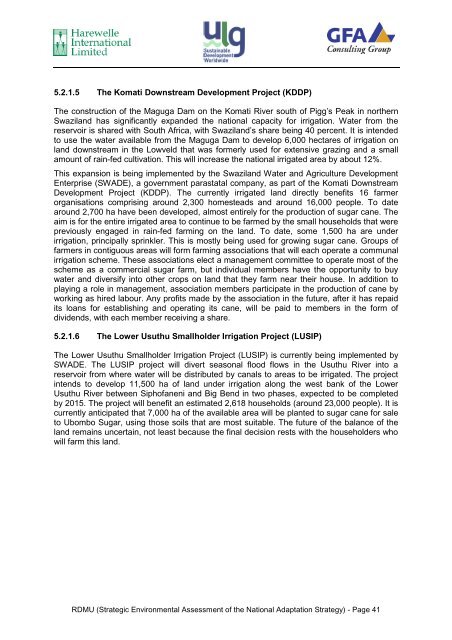Service Contract No 2007 / 147-446 Strategic ... - Swaziland
Service Contract No 2007 / 147-446 Strategic ... - Swaziland
Service Contract No 2007 / 147-446 Strategic ... - Swaziland
- No tags were found...
Create successful ePaper yourself
Turn your PDF publications into a flip-book with our unique Google optimized e-Paper software.
5.2.1.5 The Komati Downstream Development Project (KDDP)The construction of the Maguga Dam on the Komati River south of Pigg’s Peak in northern<strong>Swaziland</strong> has significantly expanded the national capacity for irrigation. Water from thereservoir is shared with South Africa, with <strong>Swaziland</strong>’s share being 40 percent. It is intendedto use the water available from the Maguga Dam to develop 6,000 hectares of irrigation onland downstream in the Lowveld that was formerly used for extensive grazing and a smallamount of rain-fed cultivation. This will increase the national irrigated area by about 12%.This expansion is being implemented by the <strong>Swaziland</strong> Water and Agriculture DevelopmentEnterprise (SWADE), a government parastatal company, as part of the Komati DownstreamDevelopment Project (KDDP). The currently irrigated land directly benefits 16 farmerorganisations comprising around 2,300 homesteads and around 16,000 people. To datearound 2,700 ha have been developed, almost entirely for the production of sugar cane. Theaim is for the entire irrigated area to continue to be farmed by the small households that werepreviously engaged in rain-fed farming on the land. To date, some 1,500 ha are underirrigation, principally sprinkler. This is mostly being used for growing sugar cane. Groups offarmers in contiguous areas will form farming associations that will each operate a communalirrigation scheme. These associations elect a management committee to operate most of thescheme as a commercial sugar farm, but individual members have the opportunity to buywater and diversify into other crops on land that they farm near their house. In addition toplaying a role in management, association members participate in the production of cane byworking as hired labour. Any profits made by the association in the future, after it has repaidits loans for establishing and operating its cane, will be paid to members in the form ofdividends, with each member receiving a share.5.2.1.6 The Lower Usuthu Smallholder Irrigation Project (LUSIP)The Lower Usuthu Smallholder Irrigation Project (LUSIP) is currently being implemented bySWADE. The LUSIP project will divert seasonal flood flows in the Usuthu River into areservoir from where water will be distributed by canals to areas to be irrigated. The projectintends to develop 11,500 ha of land under irrigation along the west bank of the LowerUsuthu River between Siphofaneni and Big Bend in two phases, expected to be completedby 2015. The project will benefit an estimated 2,618 households (around 23,000 people). It iscurrently anticipated that 7,000 ha of the available area will be planted to sugar cane for saleto Ubombo Sugar, using those soils that are most suitable. The future of the balance of theland remains uncertain, not least because the final decision rests with the householders whowill farm this land.RDMU (<strong>Strategic</strong> Environmental Assessment of the National Adaptation Strategy) - Page 41
















